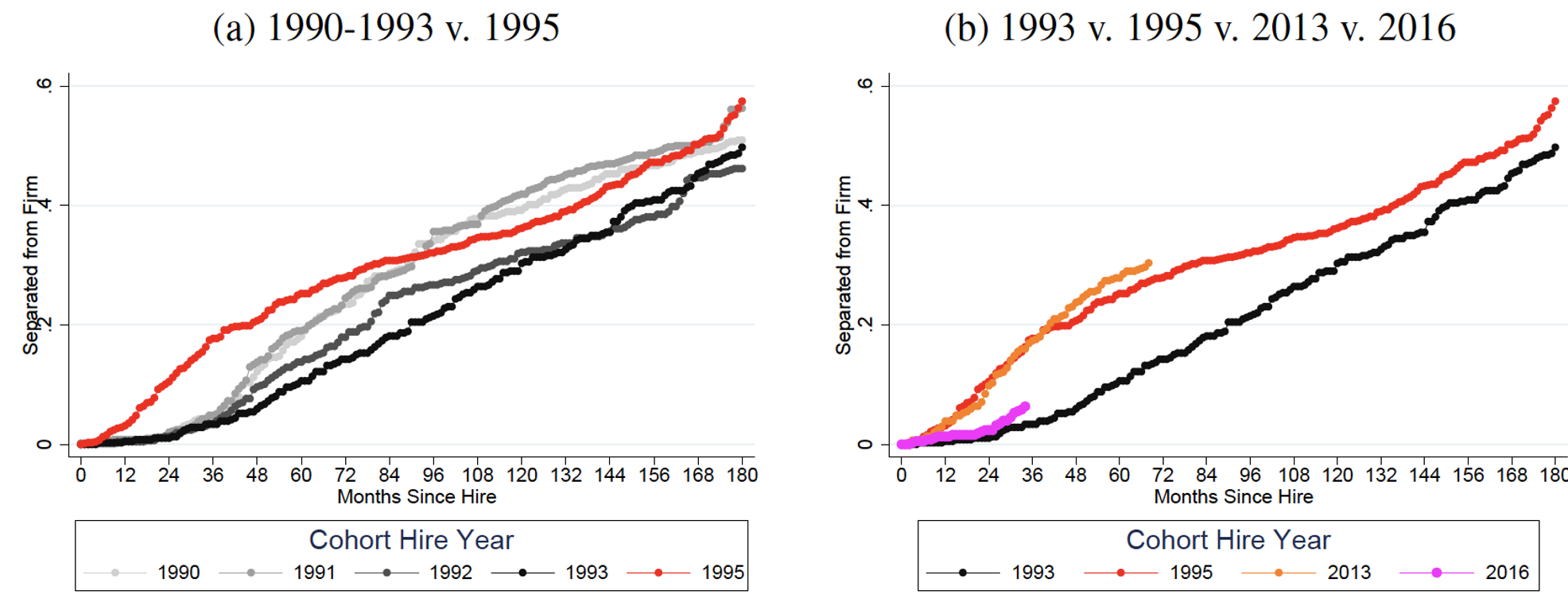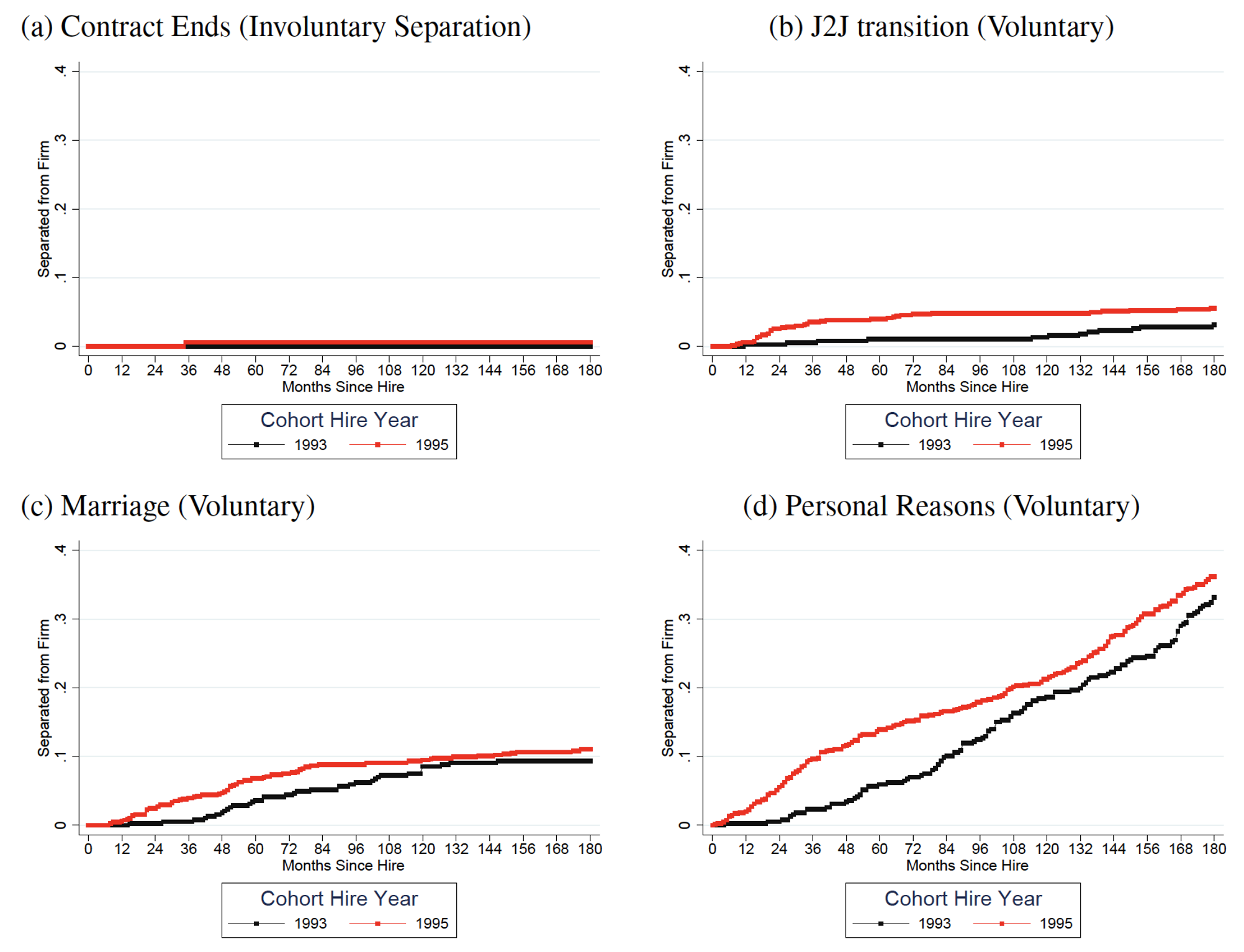Temporary work contracts promise firms and workers increased flexibility, particularly in labour markets characterised by a high degree of rigidity. At the same time, these contracts are typically a worse deal for workers relative to permanent contracts since they are associated with employment uncertainty, low pay, a lack of fringe benefits, and limited eligibility for social insurance. There is growing pressure from policymakers and workers to move away from using temporary contracts. For example, members of the United Auto Workers went on a 40-day strike against General Motors in 2019, in part to negotiate better compensation for temporary workers and a path to permanent employment (Wall Street Journal 2019). Despite the growing interest in the consequences of temporary contracts, little is known about the effects of being a temporary contract holder on young workers’ subsequent labour market and family outcomes.
Our paper (Asai and Koustas 2021) studies the causal effect of starting a career on a temporary contract, as opposed to a permanent contract. We follow (1) labour market outcomes, and (2) family formation of new graduates over 15 years. It is especially important to know the impacts of being a temporary contract holder on young workers. The first few years after entering the labour market are an important period for subsequent career development, as shown by a number of studies (e.g. Topel and Ward 1992, Oyer 2006, Kahn 2010, Genda et al. 2010, Oreopoulos et al. 2012, Altonji et al. 2016, Schwandt and von Wachter 2019, von Wachter 2020).
Further, having a temporary contract as an initial job may affect young workers' family formation, a channel that has so far received limited empirical attention in the study of initial career placement. Fertility responds positively to income when children are assumed to be normal goods (Becker 1960). Several studies in other contexts have found evidence that is consistent with this prediction: positive income shocks are associated with increased fertility (Lovenheim and Mumford 2013), and adverse income shocks such as unemployment are associated with decreased fertility (Del Bono et al. 2012, Clark and Lepinteur 2020, Currie and Schwandt 2020).
Two natural experiments varying starting contracts
The key challenge to establishing the causal effects of having a temporary contract as an initial job is that it is difficult to disentangle the effects of holding a temporary contract from the initial selection mechanisms that cause workers to hold temporary contracts. To overcome this challenge, we study natural experiments where workers were subject to industry-wide changes in their contract type. As a result, worker contract type was determined by policy changes outside the control of the worker.
Figure 1 The key experiments for the major airline in our study
Notes: Figure 1 shows the share of new flight attendants on a temporary contract from 1985 to 2018. The share on temporary contracts was 0% until 1994 and jumped to 100% from 1995 due to the industry-wide change in the hiring policy. In 2016, the policy reversed, and new flight attendants were again hired on permanent contracts.
Source: Asai and Koustas (2021)
We study two related natural experiments that occurred decades apart (Figure 1). The first comes from the mid-1990s when the major firms in the Japanese airline industry cooperated on a new industry-wide hiring policy: all newly hired flight attendants would be hired on temporary contracts instead of the standard permanent contract. Workers were promised a permanent contract after three years of continuous employment if they met standard performance goals; thus, long-run incentives were unchanged. There were no other major differences in work responsibilities; workers on temporary contracts performed the same tasks as workers hired on permanent contracts.
The second natural experiment we study occurred in the mid-2010s and is the reverse experiment. The major firms in the airline industry decided to again hire new flight attendants on permanent contracts, instead of using temporary contracts. In addition, all flight attendants who were still on temporary contracts were transitioned to permanent contracts.
Importantly, this variation in initial contract type was outside of the control of the job applicants, since applicants would typically have already received a job offer by the time policy was implemented. And because these policies were applied to all new hires, assignment to temporary contracts was unrelated to worker characteristics.
These natural experiments provide an opportunity to estimate the causal effects of initial placement into temporary contracts. Our research design compares outcomes for cohorts hired in the years before to those hired after the change in industry policy. To study these policy changes, we use detailed personnel records from one of Japan’s major airlines alongside employer-employee matched survey data from government sources.
Separation rates
Figure 2 Separation rates, by hiring cohort and months elapsed since hire
Notes: Panel (a) shows shares separated from the firm by months since hire, and by year of hire. The 1991-1993 cohorts are hired on permanent contracts, and the 1995 cohort is hired on a temporary contract. Panel (b) compares separation rates for cohorts right before and after the 1995 and 2016 policy changes. The 1993 and 2016 cohorts are hired on a permanent contract, and the 1995 and 2013 cohorts are hired on temporary contracts for the first three years.
Source: Asai and Koustas (2021)
Our first key finding is that employee retention declined dramatically for workers on temporary contracts. Figure 2 plots the share separated from the firm by the month since hire on the x-axis, for different hiring cohorts. As shown in Panel (a) of Figure 2, there was a downward trend in the separation rate from 1990 to 1993. But with the 1995 cohort, who were now hired on temporary contracts, there was a dramatic increase in the rate of separating from the firm across the distribution of time since hire. Figure 2(b) plots the separation rate for a cohort before and after each policy change, i.e. 1993, 1995, 2013, and 2016 cohorts. It is striking to see that the 2013 cohort’s separation rate – that is, the last cohort hired on a temporary contract – is nearly identical to the one for the 1995 cohort, especially for the first three years, while the 2016 cohort’s separation rate – the first cohort hired on a permanent contract – is similar to the one for the 1993 cohort, who were the last cohort hired on a permanent contract.
Overall, we find that women hired on temporary contracts are 18 percentage points (144% from the initial level) less likely to stay with the firm after three years and 11 percentage points (27%) less likely in the long run. Workers on temporary contracts also experience a 54% reduction in earnings in their first three years, although these earnings differences fade over time.
Separation reasons and family outcomes
Figure 3 Reported separation reason for flight attendants, by hiring cohort and months elapsed since hire
Notes: Figure 3 shows the raw separation rates from the firm by months since hire. Panels separate each reason for separation as recorded by the firm. Panel (a) shows the share who separate due to their contract ending, panel (b) shows the share with a job-to-job transition, panel (c) shows the share due to marriage, and panel (d) shows the share separated due to personal reasons. The black line indicates the share separating for the cohort hired in 1993, and the red line shows the share for the cohort hired in 1995.
Source: Asai and Koustas (2021)
We next decompose separations into four different reasons: contract ends, job-to-job transition, marriage, and other personal reasons (Figure 3). We find that only a small number separate due to contractual reasons initiated by the firms. Instead, workers appear to initiate most separations: workers are 3.6 percentage points (153%) more likely to separate with a job-to-job transition within their first three years of employment and 3.3 percentage points (81%) more likely in the long run. This rise in job-to-job transitions after the policy change may be explained by better outside options, given the lower starting wage. Relatedly, some workers may find current wages below their reservation wage and exit the formal labour market. We find workers are 3.9 percentage points (148%) more likely to separate due to marriage after three years with the firm, and 9.7 percentage points (138%) more likely to separate due to personal reasons during this time.
We also find that long-tenure workers hired on temporary contracts are 7 percentage points (16%) less likely to have a child, compared to those hired on a permanent contract in the immediate years prior. Combined with our large effects on retention, these large differences in childbirth outcomes may come from selection into who stays with the firm. These results are also consistent with the hypothesis that job-to-job transitions disrupt family formation, perhaps due to the need to train for a new career.
Mechanisms and implications
The potential mechanisms behind our findings are (1) lower starting salaries while on the temporary contract, (2) delayed promotion, and (3) limited access to parental leave while on a temporary contract. Lower wages and limited promotion prospects may cause higher separation and delayed childbirth. Japan has paid and job-protected parental leave since 1992, but it only covers workers on permanent contracts. Workers hired on temporary contracts after the policy change would not have been eligible for these benefits until four years after they were hired (i.e. one year after they became a permanent worker).
Our findings help to shed light on the costs and benefits of the use of temporary versus permanent contracts. We have shown that new hires on temporary contracts are less likely to remain with the firm in the long run. The workers hired on temporary contracts that do remain with the firm have children later, which has potentially important implications for Japan and other countries with declining birth rates. Given that our sample is composed mainly of women of child-bearing age, it would be interesting to see if this same finding is true for men hired on temporary contracts in future work.
Editor’s note: The main research on which this column is based (Asai and Koustas, 2021) first appeared as a Discussion Paper of the Research Institute of Economy, Trade and Industry (RIETI) of Japan.
References
Altonji, J, L Kahn and J Speer (2016), “Cashier or consultant? entry labor market conditions, field of study, and career success”, Journal of Labor Economics 34: S360–S401.
Asai, A and D Koustas (2021), “Temporary Work Contracts and Female Labor Market Outcomes”, RIETI Discussion Paper Series 21-E-071.
Becker, G (1960), "An economic analysis of fertility", in Demographic and Economic Change in Developed Countries, Columbia University Press, pp. 209–240.
Clark, A E and A Lepinteur (2020), “A natural experiment on job insecurity and fertility in France”, Review of Economics and Statistics 104(2): 386-398.
Currie, J and H Schwandt (2020), “Short- and long-term effects of unemployment on fertility”, Proceedings of the National Academy of Sciences 111: 14734–14739.
Del Bono, E, A Weber and R Winter-Ebmer (2012), “Clash of career and family: Fertility decisions after job displacement”, Journal of the European Economic Association 10: 659–683.
Genda, Y, A Kondo, S Ohta (2010), “Long-term effects of a recession at labor market entry in japan and the united states”, Journal of Human Resources 45(1): 157-196.
Kahn, L (2010), “The long-term labor market consequences of graduating from college in a bad economy”, Labour Economics 17(2): 303-316.
Lovenheim, M, K Mumford (2013), “Do family wealth shocks affect fertility choices? eEidence from the housing market”, The Review of Economics and Statistics 95: 464–475.
Oreopoulos, P, T v Wachter, A Heisz (2012), “The short- and long-term career effects of graduating in a recession”, American Economic Journal: Applied Economics 4(1): 1-29.
Oyer, P (2006), “Initial labor market conditions and long-term outcomes for economists”, Journal of Economic Perspectives 20(3): 143-160.
Topel, R and M Ward (1992), “Job mobility and the careers of young men”, The Quarterly Journal of Economics 107: 439–479.
von Wachter, T (2020), “The persistent effects of initial labor market conditions for young adults and their sources”, Journal of Economic Perspectives 34: 168–194.
Wall Street Journal (2019), “UAW Reaches Tentative Labor Deal With GM", 16 December.





